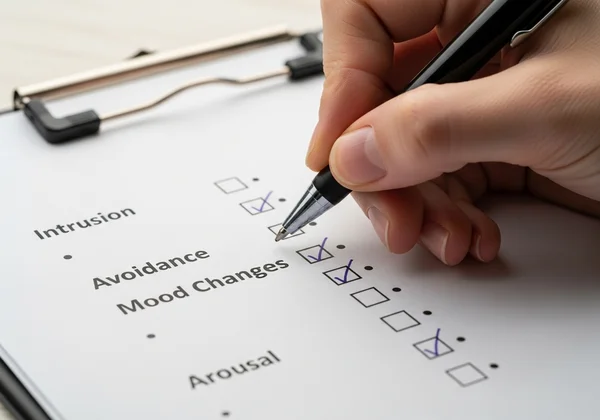How to Talk to Your Doctor About PTSD: Leveraging Your Online Test for Diagnosis
Feeling uncertain about how to talk to your doctor about PTSD? You are not alone. Taking that first step toward a professional conversation can feel intimidating, but it is a courageous and vital move for your well-being. This guide is designed to be your roadmap, empowering you to communicate your experiences confidently. By leveraging insights from a preliminary screening like the confidential PTSD test, you can turn uncertainty into action and move closer to the professional support you deserve. If you've ever asked yourself, do i have ptsd test?, you're already on the path to understanding.

Preparing for Your Doctor's Visit After a PTSD Test
With proper preparation, an anxious appointment can transform into an empowered conversation. Walking in with organized thoughts and clear information helps both you and your doctor navigate the discussion effectively. It ensures your concerns are heard and understood, paving the way for an accurate assessment.
Why Seeking Professional Help for PTSD Matters
While self-awareness is a powerful first step, a formal diagnosis from a qualified healthcare provider is crucial. A professional can differentiate between PTSD, anxiety, depression, or other conditions with overlapping symptoms. This distinction is vital as it guides the most effective treatment plan. A diagnosis opens doors to evidence-based therapies, support networks, and resources specifically designed to help you manage symptoms and begin the healing journey. It validates your experiences and confirms that what you're feeling is real and treatable.
Organizing Your Thoughts & Symptoms
When you’re feeling overwhelmed, it can be difficult to recall specific details on the spot. Before your visit, take some time to jot down your experiences. Think about the frequency, intensity, and duration of your symptoms. Consider how they impact your daily life, including your work, relationships, and sleep patterns. This process of symptom tracking not only prepares you for the appointment but also helps you see patterns you might not have noticed before.
Leveraging Your Online PTSD Test Results as a Starting Point
Your results from an online screening tool are an excellent starting point for this conversation. While not a diagnosis, they provide a structured summary of your symptoms based on established criteria like the PCL-5 checklist. You can bring a printout or a summary of your test results to your appointment. This gives your doctor a clear, concise overview of your concerns and shows that you've been proactive in understanding your mental health. It acts as a bridge, helping you translate your feelings into a language that medical professionals can work with.
Creating a "PTSD Symptoms Checklist" for Your Doctor
To make your notes even more effective, organize them into a simple checklist. Group your experiences under the main PTSD symptom clusters:
- Intrusion: Unwanted memories, flashbacks, or nightmares.
- Avoidance: Efforts to avoid thoughts, feelings, or external reminders of the traumatic event.
- Negative Alterations in Cognition and Mood: Persistent negative beliefs, feelings of detachment, or an inability to experience positive emotions.
- Alterations in Arousal and Reactivity: Irritability, hypervigilance, difficulty sleeping, or an exaggerated startle response.
Listing specific examples under each category provides a comprehensive picture of your experiences, making it easier for your doctor to conduct a thorough assessment.

What to Discuss: Effectively Talking About Your Symptoms
With your preparation complete, the next step is the conversation itself. The goal is to be open and honest, providing the necessary information for your doctor to help you. Remember, healthcare providers are trained to handle sensitive topics with compassion and professionalism.
Initiating the Conversation with Your Healthcare Provider
Starting the conversation is often the hardest part. You don’t need a perfect opening line. A simple and direct approach works best. You could say something like:
- "I’ve been struggling with my mental health since a traumatic event, and I’d like to talk about the possibility of PTSD."
- "I took an online screening tool that suggested I might have symptoms of PTSD, and I wanted to discuss the results with you."
- "I’ve been experiencing distressing memories and anxiety, and I need help understanding what’s happening."
Key Information to Share About Your Experiences
To give your doctor a full picture, be prepared to share key details about your trauma experiences. You do not have to recount every detail if it's too painful, but providing context is helpful. Be ready to discuss:
- The nature of the traumatic event (in as much detail as you are comfortable with).
- When the symptoms began.
- How the symptoms affect your work, school, and relationships.
- Any coping mechanisms you’ve been using, such as substance use or social withdrawal.
- Your physical symptoms, like fatigue, chronic pain, or digestive issues.
Questions to Ask Your Doctor About PTSD & Treatment
An appointment is a two-way conversation. Asking questions empowers you to become an active participant in your healthcare. Consider asking:
- Based on what I've shared, what are your thoughts?
- What is the diagnostic process from here?
- What are the potential treatment options if I am diagnosed with PTSD?
- Could you recommend any therapists or specialists who work with trauma?
- Are there any local support groups or resources you would suggest?
After the Appointment: Understanding Your Diagnosis & Options
Leaving the doctor's office is not the end of the process; it's the beginning of your recovery path. Whether you receive a diagnosis or not, you will have a clearer understanding of your mental health and the next steps to take.
Interpreting Potential PTSD Diagnoses and What They Mean
If you receive a formal diagnosis of PTSD, it might bring a mix of emotions—relief from having a name for your struggle, but also apprehension about the future. Remember, a diagnosis is not a label. It is a tool that allows you to access effective, targeted care. Your doctor will explain the specifics of their findings and what it means for you. They may also discuss related conditions, such as Complex PTSD (cPTSD), if your trauma was prolonged or occurred in childhood.
Exploring Next Steps: Treatment & Support Pathways
Following a diagnosis, your doctor will discuss a treatment plan. This is often a combination of therapy and, in some cases, medication. Therapies like Cognitive Behavioral Therapy (CBT) and Eye Movement Desensitization and Reprocessing (EMDR) have proven highly effective for PTSD. Your doctor can refer you to a mental health professional specializing in trauma. This is a collaborative process, and your input is essential to finding a path that feels right for you on your healing journey.

Your Next Steps Towards Healing: An Empowered Journey
Deciding to talk to your doctor about PTSD is a monumental step toward reclaiming your life from trauma. By preparing for your visit, organizing your symptoms, and using tools like an online assessment to start the conversation, you transform anxiety into advocacy for your own health. This journey requires courage, and you have already shown immense strength by seeking information.
Remember that understanding your symptoms is the first step, and professional guidance is the key to effective healing. Continue to advocate for your well-being and explore the resources available to you. Your path to recovery is unique, and every step forward, no matter how small, is a victory.
Frequently Asked Questions About Seeking a PTSD Diagnosis
What should I do immediately after taking an online PTSD test?
After taking a screening test, it's important to view the results as a preliminary insight, not a final diagnosis. The best next step is to schedule an appointment with a healthcare professional, such as your primary care physician or a mental health specialist, to discuss your results and experiences in a clinical setting.
How accurate are online PTSD screening tests?
Reputable online tests based on clinical standards like the PCL-5 are highly accurate screening tools. They are designed to identify symptoms consistent with PTSD. However, they cannot replace a comprehensive evaluation by a qualified professional, who can consider your full medical history and rule out other conditions. Think of it as a reliable first step to understand your symptoms.
Can an online test provide a definitive PTSD diagnosis?
No, an online test cannot provide a definitive diagnosis. A formal diagnosis can only be made by a licensed healthcare provider after a thorough clinical assessment. Online tools are for informational and screening purposes only, helping you decide if you should seek professional help.
What happens if PTSD symptoms are left untreated?
If left untreated, PTSD symptoms can become more severe and chronic over time. This can lead to significant impairments in daily functioning, strained relationships, job loss, and an increased risk of developing other mental health conditions like depression, anxiety disorders, and substance use issues. Early intervention is key to improving long-term outcomes.
What are the key signs of PTSD a doctor looks for during an assessment?
During an assessment, a doctor looks for the presence of four main symptom clusters following a traumatic event: intrusive memories (flashbacks, nightmares), avoidance of trauma-related reminders, negative changes in mood and thoughts (guilt, detachment), and significant changes in arousal and reactivity (hypervigilance, irritability). They will also assess the duration of these symptoms and their impact on your ability to function.